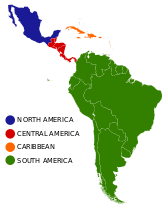- Portal:Latin America
-
- Wikipedia portals:
- Culture
- Geography
- Health
- History
- Mathematics
- Natural sciences
- People
- Philosophy
- Religion
- Society
- Technology
Latin America was a name coined by "Emperor of Mexico" Maximilian I in an effort to gain legitimacy, since his patron, Napoleon III, spoke French, a Latinate tongue like Spanish and Portuguese. Maximilian didn't last, but the coinage of "Latin America" is one of the most successful of all time. Latin America is traditionally defined as the regions of America where Spanish, the language of Spain, and Portuguese, the language of Portugal, were spoken -- in other words, every part of the Western hemisphere that was not Anglo America. (English is a Germanic language.) Therefore, virtually all of the Western Hemisphere except the United States, Canada, and the non-Hispanophone countries of the Caribbean have tended to come under the heading of Latin America. Other areas where languages derived from Latin, such as Papiamento and Creole, predominate are sometimes included and sometimes excluded from Latin America, depending on the speaker.- See also Latino, Hispanic, Ibero-America
Selected panorama
Panorama of The Ruins of Sacsayhuamán, a main sight in the City of Cusco, the historic capital of the Inca Empire and Peru. It is a major tourist destination and receives almost 1.5 million visitors a year.
Selected article
Dom Pedro II (2 December 1825 – 5 December 1891), nicknamed "the Magnanimous", was the second and last ruler of the Empire of Brazil, reigning for over 58 years. Born in Rio de Janeiro, he was the seventh child of Emperor Dom Pedro I of Brazil and Empress Dona Maria Leopoldina and thus a member of the Brazilian branch of the House of Braganza (Portuguese: Bragança). Inheriting an empire on the verge of disintegration, Pedro II turned Portuguese-speaking Brazil into an emerging power in the international arena. The nation grew to be distinguished from its Hispanic neighbors on account of its political stability, zealously guarded freedom of speech, respect for civil rights, vibrant economic growth and especially for its form of government: a functional, representative parliamentary monarchy. Brazil was also victorious in three international conflicts (the Platine War, the Uruguayan War and the Paraguayan War) under his rule, as well as prevailing in several other international disputes and domestic tensions. Pedro steadfastly pushed through the abolition of slavery despite opposition from powerful political and economic interests.Did you know...
- ... that despite 65% of Bolivians being ethnically indigenous, the first leader of that nation to come from this group was Evo Morales in 2005?
- ... that seven currencies of Latin America are named "peso"?
- ... that Frida Kahlo was bisexual, and had affairs with both men and women, including Josephine Baker?
Subportals for geopolitical entities
Selected picture
Portrait of an Argentine gaucho, a term commonly used to describe residents of the South American pampas, chacos, or Patagonian grasslands, found principally in parts of Argentina, Uruguay, Southern Chile, and Southern Brazil.
Categories
Categories:- Latin America portal
- Latin American portals
Wikimedia Foundation. 2010.





